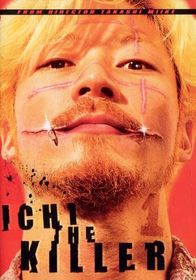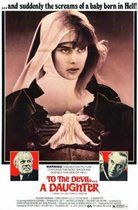Our editor-in-chief Nate Yapp is proud to have contributed to the new book Hidden Horror: A Celebration of 101 Underrated and Overlooked Fright Flicks, edited by Aaron Christensen. Another contributors include Anthony Timpone, B.J. Colangelo, Dave Alexander, Classic-Horror.com's own Robert C. Ring and John W. Bowen. Pick up a copy today from Amazon.com!
Ichi the Killer (2001)
Ichi the Killer (titled Koroshiya 1 in Japan) is one of the most brutal and intense films to come out this decade. Based on a manga by Hideo Yamamoto and directed by the prolific director of Audition, Takashi Miike, Ichi the Killer is a dark, disturbed, and often very humorous tale of sadism and violence. With no holds barred, Ichi presents extremely graphic scenes of gore that leave absolutely nothing to the imagination. While thematically it barely qualifies as a horror film, its obvious influence on later films like Hostel and Saw make it a landmark in the genre.
The Yakuza boss Anjo has disappeared along with 300 million yen. His chief enforcer, Kakihara (Tadanobu Asano), a bizarre masochistic man whose face is covered with scars and piercings, begins the search for Anjo by torturing rival gang member Suzuki (Susumu Terajima), but soon realizes that someone else has done away with the boss. That someone is Ichi (Nao Omori), a profoundly disturbed young man who is under the hypnotic control of Jijii (Shinya Tsukamoto), who is something of a mystery. Jijii had originally accused Suzuki, but we soon learn that he forces Ichi to murder his rivals by making Ichi believe he is getting revenge on childhood bullies. After a series of harsh bloodbaths, the stage is set for a final showdown between Kakihara and Ichi.
This is one of the most blood-drenched, gore-filled films I have ever seen. At times the gore is very graphic and realistic, while at other times it is wild and over-the-top. The torture scene of Suzuki is harrowing to watch, but later scenes, such as when Ichi slices an opponent completely in half, look like images taken straight from the pages of a graphic novel. When Ichi cuts the throats of his victims, they usually erupt in such a geyser of blood that it seems that there are fire hoses inside them. This type of violence is undeniably entertaining, but when it is combined with some more realistic scenes (such as a particularly disturbing rape scene), it makes it hard to decide exactly what kind of a film this is.
The plot of the film is somewhat superfluous. We don’t care that much about the machinations of the rival Yakuza gangs. The film is much more concerned with studying its two main characters, Kakihara and Ichi. Kakihara is a bizarre character. Sporting golden hair, pimp clothes, and a horribly scarred face, he is a man whose only satisfaction comes from receiving pain. This is best illustrated in a scene when, as an apology, he cuts off half of his tongue, offers it to his rival, then calmly answers his cell phone. In a sense, he is like Frank from Blue Velvet taken to an amazing extreme. Asano’s performance is chillingly effective, showing us a man who loves nothing but pain, and will literally go to any end to get it.
Ichi himself is a sad character, constantly frightened yet viciously dangerous. When he is out doing his violent deeds, he wears a black body suit equipped with razors in the heels and a white number 1 painted on the back. Omori plays him as a childish, fearful man who believes that he was tormented by bullies as a child and also believes that he was sexually aroused while watching a rape. He (and, by extension, we) can’t trust his past, however, because Jijii hypnotically changes his memories whenever he finds it necessary. Ichi, as he often says, hates killing people, but Jijii is able to convince him that he must constantly avenge himself. He is reminiscent of Travis Bickle from Taxi Driver, especially in the way he wears his weapons. Together, Ichi and Kakihara work in consort, creating a balance between those who need pain, and those who need to inflict it.
Beyond the film’s wild violence and scenes of torture, Ichi does seem to be trying to say something about the nature of violence and pain. Kakihara is unable to get pleasure from anything other than pain, and Ichi always becomes aroused when he is thinking of beating women. Nearly every important character in the film has been severely abused at some point in their lives, which is the reason why they now live mired in violence. Even the one example of innocence, a child that witnesses Ichi kill his father, starts savagely beating Ichi until Ichi kills the child. The implication is that violence constantly perpetuates itself on the young, who, as they grow older, can have no sense of pleasure unless it is combined with pain (this is evident in a woman who is almost as masochistic as Kakihara himself). There is no escape from this bleak view in this film, and we are left with the sense that extreme violence is now a common way of life.
This film does have its share of problems. Its biggest flaw is, ironically, one of its assets: its perversely funny sense of black humor. At times it can be extremely funny in a Monty Python type of way. The scene where Kakihara cuts off part of his tongue is comedic because the reactions of everyone watching him are hilarious. Another scene in which a skinned off face slides down a wall also can inspire some perverse laughs. There are many such scenes, but then they are combined with very sober, brutal scenes of violence and torture. These scenes, particularly the rape scenes, are distinctly harrowing, and are done with utter seriousness. We’re never sure if Miike wants this to be an over the top comic book, or a sincere examination of the effects of violence. The result is a terribly schizophrenic film that has the power to make us laugh, but, with its realistic violence, makes us wonder exactly what the director wants the film to be.
Overall, Ichi the Killer is not an experience for the faint of heart. It is one of the goriest movies ever made (it makes Hostel look tame), filmed with a great deal of spirit and enthusiasm. Offering two memorable lead characters, and boasting extremely brutal scenes of violence and torture, this film is definitely an unforgettable experience.
This review is part of Southeast Asian Horror Week, the fourth of five celebrations of international horror done for our Shocktober 2008 event.








